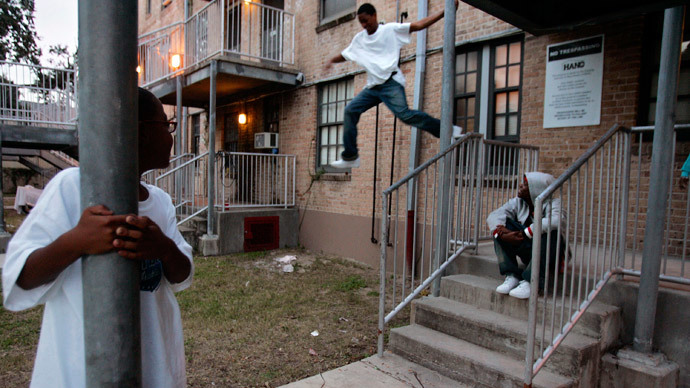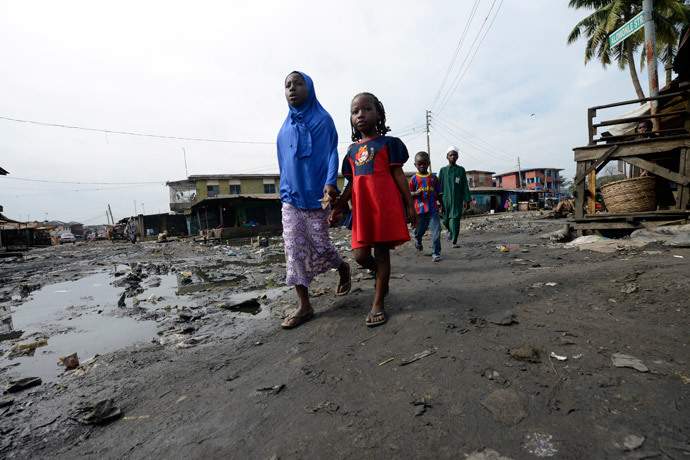Poor teens in Baltimore face worse conditions than those in Nigeria - study

A global study of adolescents from low-income neighborhoods revealed that teenagers from Baltimore, a city located just 40 miles from the US capital, are faring worse than their counterparts in Nigeria.
Many people tend to associate child poverty with desperate scenes out of Africa or India. But according to a recent WAVE study, an international survey that examined the living conditions of 15-19 year olds in poor areas in Baltimore, Shanghai, Johannesburg, New Delhi and Ibadan (third largest city in Nigeria), the problem is much closer to home than many people realize.
READ MORE:China overtakes Japan to become world’s second largest stock market
In the five neighborhoods examined in the study, poverty was the common thread that linked these culturally diverse locations. Differences among the teens in these urban areas became obvious, however, when it came to how they perceived their state of well-being.
Teens from Baltimore and Johannesburg, South Africa, viewed their
communities more negatively than the other locations in the
study.
The two cities showed the lowest number of teenagers who felt
safe in their neighborhoods (percentages ranged from 43.9 percent
among males in Johannesburg to 66.1 percent of females in
Baltimore), as well as the highest averages for witnessing
violence (8.9 percent for males and 7.0 percent among females in
Johannesburg; 7.0 percent among males and 6.3 percent among
females in Baltimore).

These two cities also showed “poor perceptions about their
physical environments, their sense of social cohesion, and their
sense of safety within their neighborhoods.”
In Baltimore, teenagers exhibited high rates of mental health
problems, drug abuse, sexual violence and teen pregnancy. In
comparison, teens in New Delhi, despite residing in a much poorer
country than the United States, showed fewer signs of such social
behavior.
The lead author of the study, Kristen Mmari, assistant professor
at Johns Hopkins Department of Population, Family and
Reproductive Health, said the perception teenagers have of their
communities plays a large role in how they behave.
“For example, a young man in New Delhi and a young man in
Baltimore may both live in neighborhoods with poor living
conditions and little opportunity, but because the teenager in
New Delhi is able to see his environment in a more positive
light, he is less likely to experience to adverse health
problems,” Mmari told Vocativ. “He paints a different
picture.”
Also, the prevalence of violence and weak social cohesion, which
ranks higher in Baltimore and Johannesburg than in the three
other cities, also has an impact. In Baltimore, a high number of
teenagers from impoverished homes grow up in single-parent homes,
in many cases with the father in prison, while many adolescents
in Johannesburg have lost a parent to HIV/AIDS.

“When you look at how they perceive their environments, kids in both Baltimore and Johannesburg are fearful. They don’t feel safe from violence,” Mmari said. “This is something we didn’t really see in other cities. In Shanghai, for example, there wasn’t a great deal of violence. You’d ask kids about their safety concerns, and they would say something like, ‘I’m afraid of crossing a busy street.’”
The study indicates a connection between the prevalence of violence and weak social bonds with issues of a sexual nature. Fifty percent of adolescent girls in Baltimore, and 29 percent in Johannesburg, had been pregnant, while more than 10 percent of teenage girls in both cities said they have been raped or assaulted by someone in the previous year.

The study tends to show that the issue of poverty, together with its many disturbing social symptoms, is a worldwide phenomenon. The results also show that the total wealth of a nation is not necessarily linked to the social circumstances of a large portion of its population.
READ MORE:‘BRICS system’ – healthy alternative to ‘defunct dollar system’
The study concluded that individuals from Baltimore and
Johannesburg give their neighborhoods the lowest ratings, while
people from Ibadan and Shanghai recorded the highest ratings.
Citizens from New Delhi ranked in the midrange.
“It is worth noting that in spite of its location in a
high-income country, the Baltimore neighborhood had some of the
lowest ratings,” Freya Sonenstein, of the Johns Hopkins
Bloomberg School of Public Health, wrote in the study’s
introduction. “In contrast, Ibadan with its high ratings is
located in a lower middle-income country with substantially fewer
resources.”













